Introduction
- Books Name
- CBSE Class 6 Science Book
- Publication
- Param Publication
- Course
- CBSE Class 6
- Subject
- Science
Introduction
You see a large variety of things around you. Some of these - such as tables, chairs, clothes, rivers, oceans, sand, etc. are called non-living things. Plants and animals are living things. All these living and non-living things have different shapes and sizes. Living organisms have several characteristics which rnake them different from non-living things.
The Living Organisms Characteristics and Habitats
- Books Name
- CBSE Class 6 Science Book
- Publication
- Param Publication
- Course
- CBSE Class 6
- Subject
- Science
CHARACTERISTICS OF LIVING THINGS
• Definite Shape and Size
Each kind of living being possesses a characteristic form and size. For example, a dog always has a form different from a bird. Different breeds of dogs may vary slightly in height and other features but they all have a more or less similar form.
• Living Things are Made up of Cells
Just as a building is made up of stones or bricks, all living organisms are made up of cells. Non-living objects do not have cellular structure. Cells are too small to be seen without a microscope.
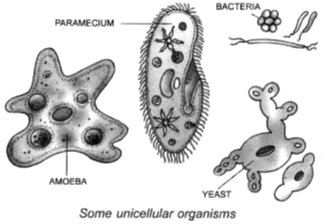
Some plants and animals consist of only a single cell and are called unicellular organisms. Some examples of unicellular organisms are: amoeba, paramecium, bacterium and yeast. There are other plants and animals whose body is made up of many cells. They are called multicellular organisms. Man, cat, pine, rose plant, etc. are such organisms.
• Living Things Move
Movement is one of the most important signs of life. Most animals move about freely from place to place. This is called locomotion. They move from place to place to find food, shelter and to escape from their enemies.Plants remain fixed to the soil at one place. They show movements of their parts. Roots always grow towards soil and shoot towards light. Opening and closing of stomata and flowers are other examples of plant movemens.
• Living Things are Sensitive
You show some immediate response to the situations you are facing. The dust particles, the hot object and the delicious dish are the stimuli. Closing and rubbing of eyes, withdrawing of hand, and water in the mouth are the responses.
All living organisms respond to stimuli because of sensitivity or irritability or responsiveness.
Plants also respond to stimuli. Many flowers open early in the morning and close during the day. Rat-ki-rani flowers open at night and close during the day. The leaves of the Mimosa the sensitive ‘Touch-me-not’ plant, fold and droop on touchin.
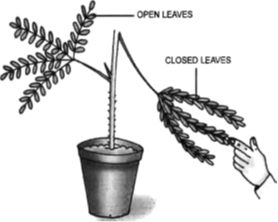
• Living Things Need food to Live
Different living organisms have different methods of getting food. All green plants can make their own food with carbon dioxide, water, chlorophyll and sunlight. The process is called photosynthesis.
Animals cannot make their own food. Th depend upon other living or dead organisms for their food. Goats, cows, buffaloes, sheep, rabbits and elephants eat only plants and are called herbivorous animals. Lions, wolves and leopards are called carnivorous animals because they feed on the flesh of other animals. Omnivorous animals like man, bear, etc. eat plants as well as animals.
• Living Things Respire
All living organisms respire. During respiration they take in oxygen and give out carbon dioxide. During respiration the food present in their body is broken down with the help of oxygen to release energy.
Plants also take in oxygen break down the food prepared during photosynthesis to release energy. They also give out carbon dioxide during respiration like animals.
• Living Things Excrete
All living organisms get rid of the waste and other harmful substances formed in their bodies. This process is called excretion. Human beings get rid of waste products from their bodies as urine, sweat, exhaled air, and as solid wastes in the form of faeces.
All animals have special organs for excretion. Kidneys, lungs, gills and sweat glands are the excretory organs of animals.
Plants throw out their gaseous waste products through small openings which are present in their leaves. These openings are called stomata. The other excretory products of plants are gums and resins.
The Living Organisms Characteristics and Habitats
- Books Name
- Class 6 Science Book
- Publication
- PathSet Publications
- Course
- CBSE Class 6
- Subject
- Science
The Living Organisms Characteristics and Habitats
Introduction: Different regions in the world have various types of living creatures called organisms. Even the openings of volcanoes have tiny living organisms. Even our homes are not devoid of these tiny organisms. List some of the tiny organisms which you have encountered at home!
Environment: Everything that we see surrounding us; living, non-living, physical, chemical etc. is called as environment
Organisms and The Surroundings Where They Live
- Books Name
- CBSE Class 6 Science Book
- Publication
- Param Publication
- Course
- CBSE Class 6
- Subject
- Science
• Living Things Grow
All living things show growth. You are familiar with the growth of a baby into an adult. Plants also grow. Farmers plant seedlings in the field which in due course of time grow into matured plants. Growth in living thing is permanent and irreversible.
• Living Things Reproduce
All living organisms reproduce their own kind. Different animals show different mode of reproduction. Some animals produce their young ones through eggs, for example, hen, snake etc. Some animals like man, cow, sheep, goat, etc. give birth to young ones.
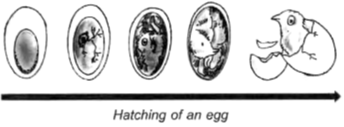
Plants also reproduce through seeds. Seeds are sown in the soil which on germination grow into new plants. Some plants can reproduce from their stems, roots, leaves or cuttings.
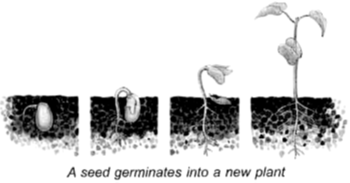
• Living Things Have a Definite Lifespan
Life Cycle : Living things follow a life cycle. They start their life form a single cell. In case of animals, the life cycle consists of birth, growth, reproduction and death .In plants, life cycle begins through seeds or spores. The life cycle of an organism may take a few hours, a few days or hundreds of years to complete.The period during which an organism completes its life cycle is called its life span. In case of bacteria, for example, the life span is very short.
• Lifespan of Some Organisms
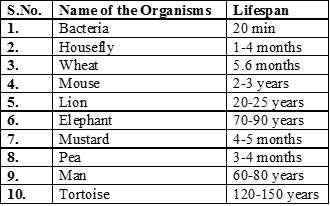
Do you know :
Father of Bilogy – the ancient Greek philosopher, Aristotle (384-322 B.C.) is known as the father of biology.
• Are there things in between living and non living : Yes, viruses are such entities existing in the universe. Viruses grow and multiply only when they are inside living things like man. Outside living bodies, they are lifeless and are just like a crystal.
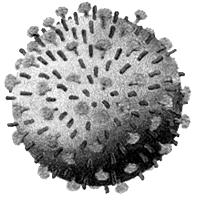
Organisms and The Surroundings Where They Live
- Books Name
- Class 6 Science Book
- Publication
- PathSet Publications
- Course
- CBSE Class 6
- Subject
- Science
Organisms And The Surroundings Where They Live
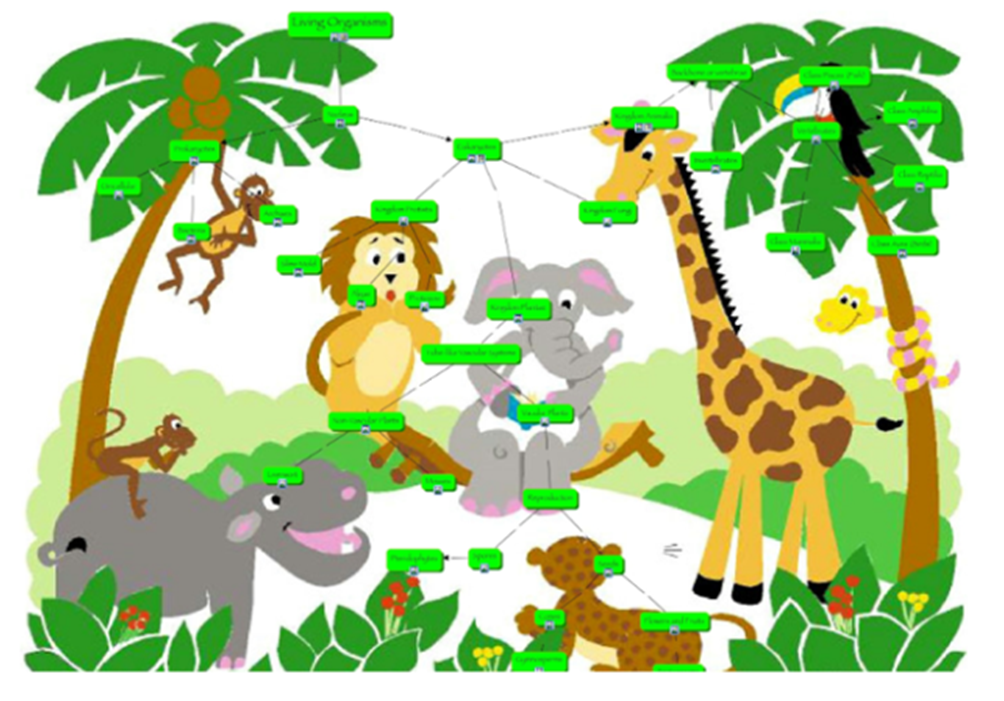
Biotic Components: These are the living components of the ecosystem. e.g. flora and fauna
Abiotic Components: The non-living components of the ecosystem like soil, water, air etc. are called abiotic components.
We all are surrounded by plants, trees, animals, birds, microbes, and other living and nonliving things based on certain parameters. Scientists were able to differentiate between:
- Living things
- Non-living things
Organisms and the surroundings where they live
The table shows some common organisms and their place to live
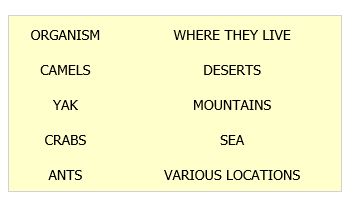
Habitat and adaption
- Books Name
- CBSE Class 6 Science Book
- Publication
- Param Publication
- Course
- CBSE Class 6
- Subject
- Science
Habitat And Adaptation
(a) Habitat :
The term habitat refers to the surroundings where organisms live.Every habitat is home for a certain living creature. Plants and animals have different features that help them to survive in their own habitat.
The components in a habitat are broadly classified into two types. they are biotic and abiotic.
Biotic components include all the livings organisms in a habitat. Abiotic components include all the non-living things in a habitat. These include air, rocks, water, sunlight and heat. All livings things depend on the abiotic components for all their needs. The abiotic components are very useful for the survival of the biotic components in a habitat. For example, sprouting is the first step where a new plant grows from a seed. The sprouting of a seed depends on abiotic components such as air, water, light and heat.
• The population of some species of turtles has declined due to the change in the earth’s temperature.
• Some popular theories believe that dinosaurs became extinct because of the changes in the earth’s temperature millions of years ago.
• Habitat can be terrestrial or aquatic :
• Terrestrial habitat : It refers to the land where all plants and animals survive. It includes mountains, deserts, forests and grasslands, as well as coastal and mountain regions. For example, camels and cactus plants live in deserts only.
• Aquatic habitat : It refers to the water where plants and animals survive. Aquatic habitat includes rivers, ponds, lakes, ocean and swamps.
(b) Adaptation :
Plants and animals develop certain features or certain habits that help them survive in their surroundings, and this is known as adaption. Different living creatures adapt to their habitats in different ways. For example, fish have gills that help them to live in water and use the oxygen dissolve in it. Plants that live in water have special tissues that help to take in dissoved gas from water. For example the ulva has ribbon-like leaves.
It takes thousands of years for a livings being to adapt to its habitat.
Habitat and adaption
- Books Name
- Class 6 Science Book
- Publication
- PathSet Publications
- Course
- CBSE Class 6
- Subject
- Science
Habitat And Adaptation
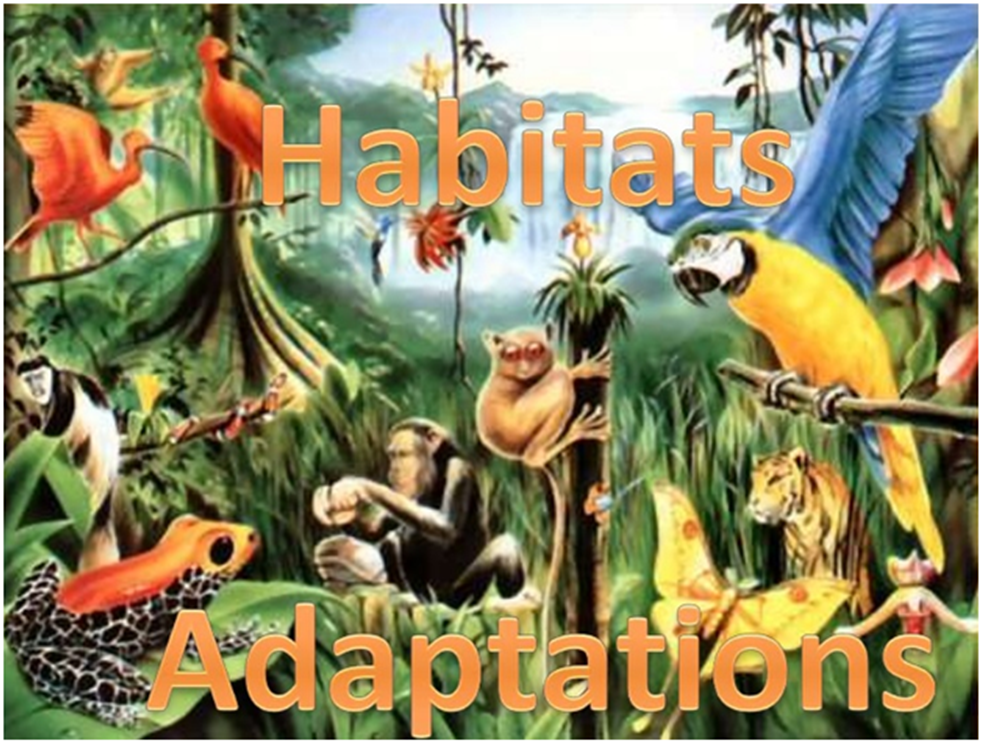
Animals benefit a lot from their habitats. For example, rabbits live in a forest habitat by building a burrow in the soil; they get food from the plant products; they obtain fresh air they breathe. Habitat provides air, food, water and shelter to an animal.
The place where an organism naturally lives and reproduces is called a habitat.
The soil and climate conditions on land are varied in different parts of the earth. Organisms tend to adjust to the conditions and environment they live in. The unique characteristics of plants and animals that enable them to successfully survive in a particular environment are called as adaptation.
Light :
- The sunlight is essential for the survival of the biotic components as the sun is the ultimate source of energy for all living things.
- The sunlight affects growth, flowering, seed germination and in many other ways in plants. Indoor plants put in the shade for a long time grow faster but become delicate and weak.
- Light also affects animals. Animals living in caves and burrows where sunlight cannot reach have very much reduced eyes e.g., Proteus. Amblyopsis do not have eyes.
- Nocturnal animals: Some animals like bats, cockroaches and owls are called nocturnal as they are active during the night.
Temperature :
- Temperature regulates growth, movement, reproduction, morphology and other aspects of life.
- Animals living in hot areas e.g., snakes, desert rats and lizards are not able to get sufficient water. They have thick skin and do not sweat.
- Desert animals e.g., camels have long legs. Long legs help them to lift their body above the ground. Thus, they can avoid direct contact with the hot ground.
Water :
All living organisms need water for their survival.
Aquatic plants:
Aquatic plants have the following adaptations:
- The root system is poorly developed.
- Air-filled cavities found inside the body make them spongy and buoyant.
- Leaves in submerged plants are thin and narrow; while in floating plants, they are big and flat with a waxy coating.
Desert plants:
Desert plants carry the following adaptations:
- Well-developed root systems.
- Stem is succulent and spongy which helps in storage of water. It is also green and performs photosynthesis.
- Stomata (sunken) are less in number.
- Leaves are either very small or converted into spines.
Habitat and Adaptation
The region or place where an organism lives is termed as its habitat. Habitat provides an organism everything it needs to survive like food, shelter, proper weather conditions such as rainfall, heat etc. to breed and flourish.
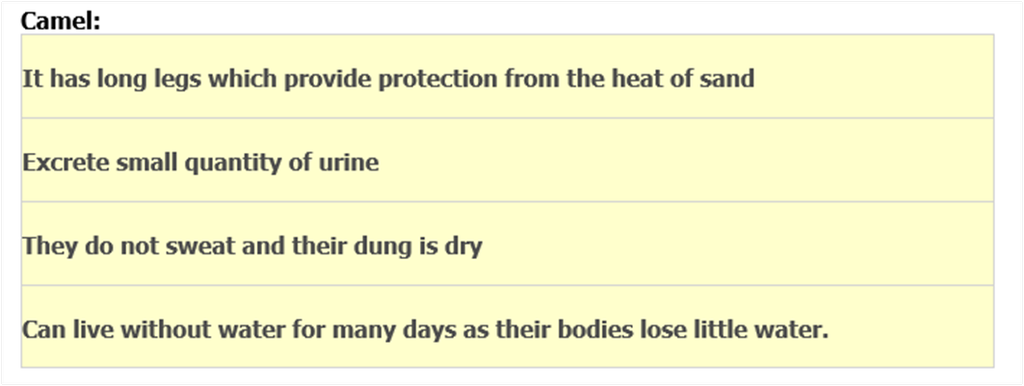
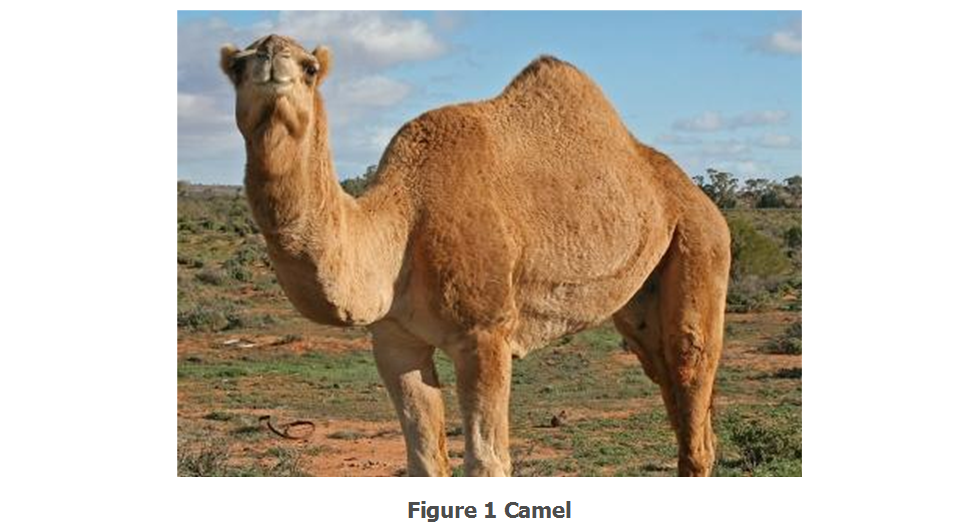
Fish
- Their streamline shape helps to move easily in water
- Presence of slippery scales
Gills help in respiration.
- Flat fins and tail help in changing direction in the water
- Tapering ends.
A journey through different habitats
- Books Name
- CBSE Class 6 Science Book
- Publication
- Param Publication
- Course
- CBSE Class 6
- Subject
- Science
• Adaptation in different habitats :
A. Terrestrial Habitats :
(i) Deserts : Desert is a water depleted area so basically plants and animals are adapted for little or less of water. Deserts are areas which receive very little rainfall. Sahara and Kalahari are two examples of deserts. Deserts are very hot and dry. Camels, cactus, date palm tree, rattle snake, are example of organisms found in deserts.
Adaptation In Desert Animals and Plants :
• Desert animals include camel, rats and snakes.
• To stay away from the intense heat during the day, rats and snakes stay in burrows deep in the sand. They come out only during the night, when it is cooler.
• Camel’s nostrils have long hairs to prevent the entry of sand and dust. They have no sweat glands in their skin.
• Adaptation in desert plants lose very less little water through transpiration.
• Desert plants either have no leaves or they have small or spine shaped leaves to reduce transpiration.
• Photosynthesis is usually carried out by stems.
• The stem is covered with a thick waxy layer which helps it to retain water.
• They have deep roots for absorbing water.
• Stomata are few, sunken in pits or covered with fine hairs.
(ii) Mountain regions : They are normally very cold and windy. In some places, snowfall may take place during winter.
• The leaves of some trees are needle - like so that snow and rain water can slide off easily.
• Animals have thick skin or fur to protect them from cold.
• Yaks have long hair to keep them warm.
• Snow leopard has thick fur on its body including feet and toes. This protects its feet from the cold when it walks on the snow.
• The mountain goat has strong hooves for running up the rocky slopes of the mountains.
(iii) Grasslands
• Lion lives in grassland.
• Its light brown colour helps it to hide in dry grasslands when it hunts for prey.
• The eyes in front of the face allow it to have a correct idea about the location of its prey.
• A deer has strong teeth for chewing hard plant stems.
• It has long ears to hear the movement of the predators.
• The eyes on the side of its head allow it look in all directions for danger.
• The speed of the deer helps them to run away from the predators.
B. Aquatic Habitats :
• Aquatic Adaptations
The animals which live in water are known as aquatic animals. Common aquatic animals -are fish, whale, crab, octopus, lobster, etc.
• They have the following adaptations:
1. They have streamlined body without a neck.
2. They have powerful tail and fins for swim.ming.
3. They have gills for respiration.
4. Some fishes have air bladder to make floating easier.
5. They have special body covering like cuticle, scales, shells and waxy coating which prevent rotting and decay.
A journey through different habitats
- Books Name
- Class 6 Science Book
- Publication
- PathSet Publications
- Course
- CBSE Class 6
- Subject
- Science
A Journey Through Different Habitats

Aquatic habitat
When organisms live in water, this place of living is known as aquatic habitat.
- Ponds, lakes, rivers, oceans, etc., are examples of aquatic habitats.
- Water is a medium in aquatic habitats.

Marine Habitat
- Marine Habitat comprises of oceans and seas, and both have saltwater.
- They are home to a wide variety of creatures like the most part of fish population is found here.
- Marine creatures are found in Estuaries – where rivers and oceans meet and the water is salty.
- Marine Mammals like whales migrate to long distances in order to cope up with the temperature changes.
Oceans
- Most organisms have streamlined bodies and gills
- Octopuses do not have streamlined bodies so they stay deep in ocean, but when moving they make a streamline motion.
- Whales have blowholes instead of gills This enables them to breathe easily when they swim near the surface of water.
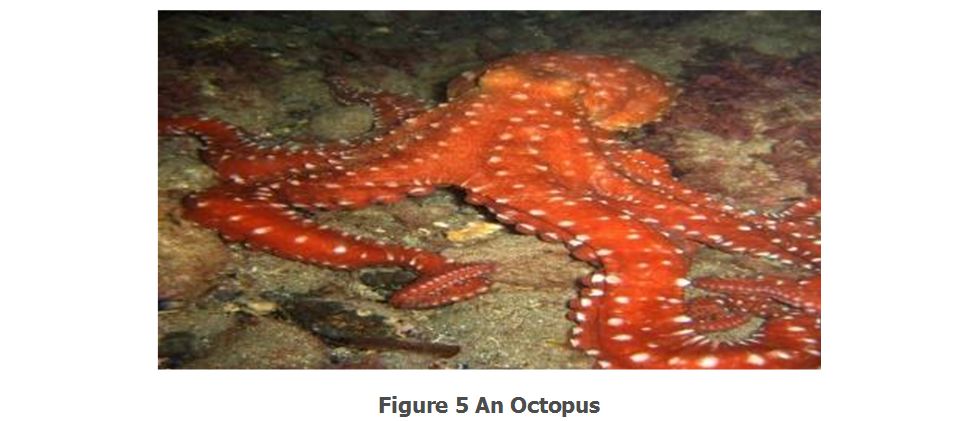
Freshwater Habitat:
- Rivers, lakes, ponds etc comprise the freshwater habitats.
- Three percent of world’s water is accounted as freshwater but still a wide variety of species are found here.
- Snails, worms, mollusks etc are found in this habitat
Ponds and Lakes:
- Plants: Water plants can be completely submerged in water (like Hydrilla) or floating on the surface of water(like Water Lily, Lotus, Water Hyacinth). Roots are much reduced in size, since their main function is to hold the plant in place. Stems of aquatic plants are long, hollow and light so that these can bend in along with water movement. e.g Water Lily. The stems grow up to surface of water, while the leaves and flowers float on surface of water.
- Totally submerged plants have narrow and ribbon like leaves (e.g tape grass). These can bend in flowing water.
- Stems have air spaces to enable the plant to float. Floating plants are large and flat. They have waxy upper surfaces that makes them waterproof. They have stomata on the upper surfaces which are exposed to air.
- Frogs are adapted to live both on land and water, they have strong back and legs and webbed feet which allows them to swim in water.
Coastal Habitat:
- Habitats where the land meets the sea.
- Beaches, special type of trees called mangroves are found in this habitat
- Coastal plants like seaweed attach to the rocks firmly so that they are not swayed by the waves,
Acclimatisation: Due to certain changes in the surroundings, organisms adapt through them by making small changes in the body over short periods of time.
For e.g: The changes which take place in the body when we travel from plains to mountains. The adjustment which the body makes is called Acclimatisation
Terrestrial Habitat:
a) Deserts:
The following adaptations of various organisms are enlisted below:
- Snakes and rats dig burrows to escape intense heat as they dont have long legs such as a camel. These animals come out only during the night, when it is cooler
- In desert plants leaves are reduced to spines and lose little water through transpiration
- The stems of desert plants have a waxy coating on them and in most of them photosynthesis is carried out by the stem
- Their roots go deep into the soil so as to absorb water.
- The leaves in desert plants are absent to prevent loss of water due to transpiration.
- Some of the animals are camels, kangaroo rats etc
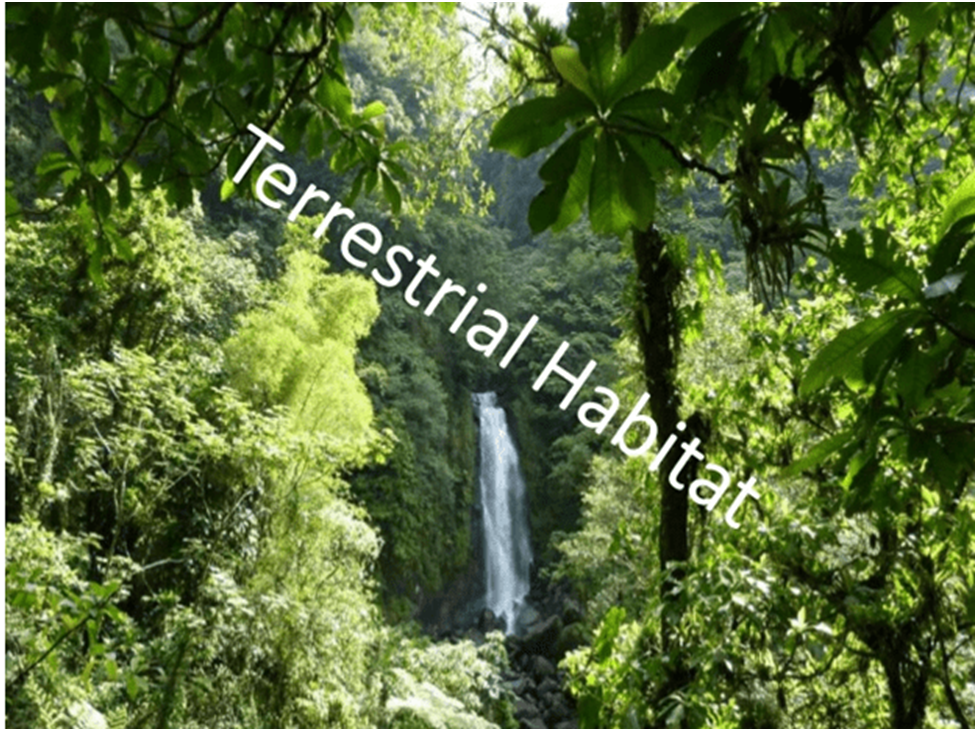
When organisms live on land, this place of living is known as terrestrial habitat.
- Forests, deserts, orchards, tea gardens and mountains are examples of terrestrial habitat.
- Air is the medium in terrestrial habitats.
Mountain

b) Mountain Regions:
- The trees are cone shaped with slope like branches, also needle-like leaves are present so that rain and snow slide off them easily.
- Animals have thick fur which provides protection from cold. e.g. Snow Leopard
- Presence of strong hooves help the mountain goat to run on the rocky slopes.
- Eg are Pines, mountain goats, yaks, sheep etc. Yaks have long hair to keep them warm.
- The mountain is a special terrestrial habitat where temperature is very low and most of the areas are covered with snow.
- The plants like grasses, mosses and lichens and animals like snow bear, fox, water fowl, musk deer and wolf are found commonly in this habitat
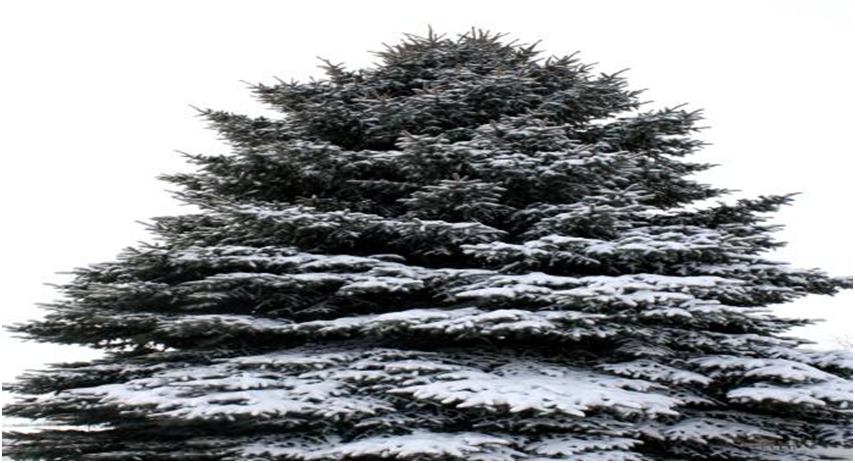
A tree found in mountain region
c) Grasslands:
- The light brown colour of the lion helps it to hide in dry grasslands and the presence of long claws help to capture the prey.
- Deer has strong teeth to eat plant stems also its long ears help to listen to predator movement. They have eyes on its sides of the head which help them to look in all directions to lookout for danger.
- Some of the animals living in these habitats are elephants, giraffes, lions.
d) Rainforest:
- This habitat receives a lot of rain and hence its rich in animal life.
- Mammals, Amphibians, Reptiles all sorts of animals are found here.
- The climate is hot and humid and animals have to learn to adapt to survive.
e) Polar Habitat:
- These habitats are very cold and windy.
- The animals are mostly carnivores and have thick fur to survive in cold.
- Some blend in ice and some may hibernate in the coldest months.
- Examples of animals are polar bears, reindeers, penguins etc.
Characteristics of organisms
- Books Name
- CBSE Class 6 Science Book
- Publication
- Param Publication
- Course
- CBSE Class 6
- Subject
- Science
Oceans :
• Sea animals like squid and octopus stay near the seabed and catch any prey that move towards them. When they move in water, they make their body shapes streamlined.
• Generally aquatic animals have gills to help them use the oxygen dissolved in water.
• Dolphins and whales do not have gills. They breathe in air through nostrils or blowholes that are located on the upper parts of their heads.This allows them to breathe in air when they swim near the surface of water.
• They can stay inside the water for a long time without breathing.
(ii) Ponds and Lakes
• Roots of plants are much reduced in size and their main function is to hold the plant in place.
• The stem is long, hollow and light.
• The stems grow upto the surface of water while the leaves and flowers float on the surface of water.
• Some plants are totally submerged in water, i.e, all parts of the plant grow under water. These plants have narrow and thin ribbon like leaves. Through highly divided leaves, the water can easily flow without damaging them.
• Amphibious Adptations In Animals
The animals which can live both on land as well as in water are called amphibious animals. Common amphibious animals are: frogs, toads and salamanders.
They have the following adaptations:
1. The skin is moist and slimy which help in respiration.
2. They can also respire through lungs.
3. The hind legs are long and strong which help in hopping movements on the land.
4. They have webbed feet for swimming.
C. Aerial or Volant Adaptations
Animals which are adapted for the aerial mode of life (flying) are known as volant animals. Common volant animals are an birds and bats.
They have the following adaptations:
1. They have streamlined body which is covered with feathers.
2. Their forelimbs are modified into wings.
3. The bones are light, hollow, spongy and contain many air cavities.
4. They have lungs for respiration.
5. The nervous system and sense organs are well developed.
6. The flight muscles are well-developed and their eyesight is very sharp.
Characteristics of organisms
- Books Name
- Class 6 Science Book
- Publication
- PathSet Publications
- Course
- CBSE Class 6
- Subject
- Science
Characteristics of Organisms
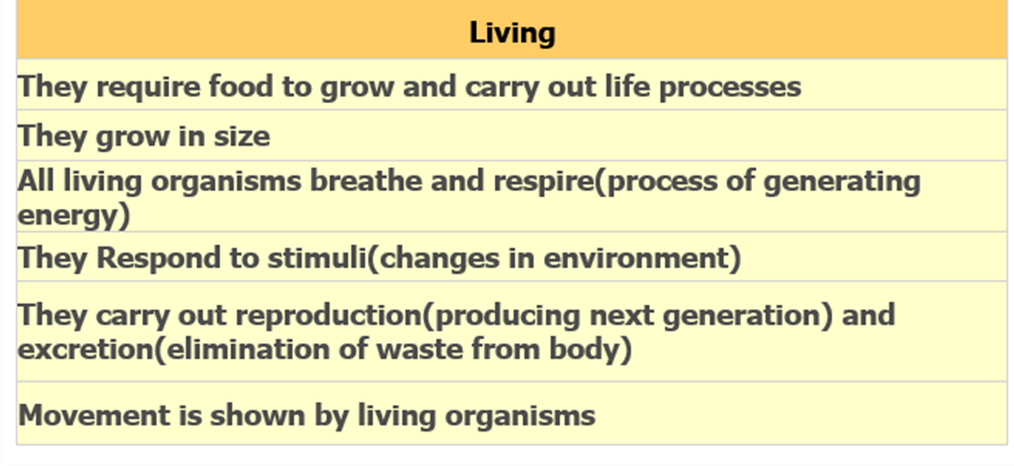
Life is a process seen only in living objects in the form of growth, movement, feeding or eating, sensitivity, respiration, excretion and reproduction. All living things on this earth possess certain basic characteristics.
Life Span: Each animal lives for a certain period. This period is referred to as life span.
These include the following:
- Growth
- Movement
- Feeding
- Responsiveness
- Excretion
- Respiration
- Cellular structure
- Reproduction
- Adaptation
Growth:
Growth is defined as the permanent irreversible increase in the size and total weight of the living object.
- Animals grow for a certain period.
- In the case of trees, growth takes place throughout life.
- Growth in plants and animals is influenced by several factors like food, climate, lifestyle, etc.
Movement:
Change in the position from one place to another is called movement.
- Locomotion: The movement involving a change of place in animals is called locomotion.
- Animals use wings (bird), fins (fish), limbs (cow, horse, buffalo, man) for locomotion.
- Plants generally show movements of various parts, e.g., flower buds open, roots grow away from light, when we touch the leaves of mimosa (touch me not), they shrivel up.
Cellular Structure :
- Cells constitute plants and animal bodies.
- Cells are organised in various ways in different organisms.
- They help in carrying out various functions like nutrition, respiration, etc.
- They are called the structural and functional unit of all living organisms.
Nutrition:
The process of taking food by organisms is generally referred to as nutrition or nourishment. Food and water are essential for life. Food provides energy that helps in the growth of the body and its repair.
- Autotrophs: They are the living forms which can synthesize their own food by photosynthesis, e.g., green plants.
- Heterotrophs: They are living organisms which cannot manufacture their own food, e.g., all animals.
- Saprophytes: The living organisms which obtain their nutrition from the dead plants and animals are called saprophytes.
- Parasites: The plants and animals that feed on the other living bodies are called parasites.
Respiration :
- Respiration is a process in which oxygen taken by an organism combines with reserved food, undergoes oxidation and releases energy.
- Breathing: Taking in air and releasing it in animals is referred to as breathing.
- We inhale oxygen (O2) and exhale carbon dioxide (CO2).
Excretion :
- The removal of excretory waste from the body of a living being is called excretion.
- The process of removal of wastes in plants is referred to as secretion.
- Latex, resin and gum are wastes for the plant but useful for us.
Response to Stimuli :
- Living beings respond to changes in their surroundings.
- Stimuli: The factors like food, water, light, touch, gravitational force, etc., are stimuli (stimulus) to which plants and animals respond.
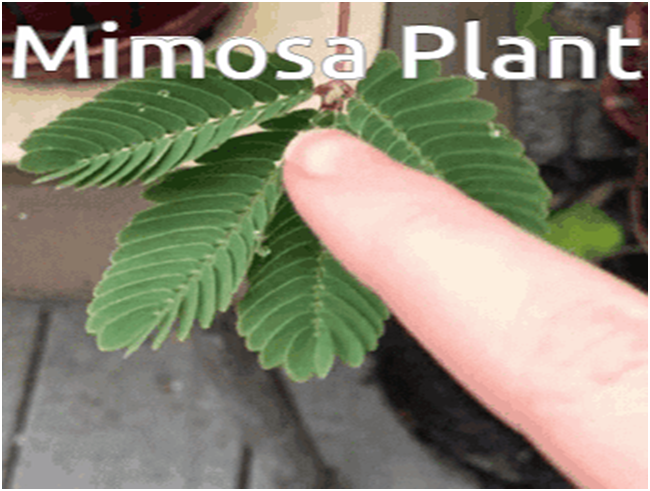
Reproduction:
- The process of a living being to produce of its own kind is called reproduction.
- Life produces life.
- Plants reproduce through seeds. Some plants also reproduce through vegetative parts.
Conclusion:
- Adaptation: The change in specific features and habits which enable a plant or an animal to live in a particular habitat is called adaptation.
- Aquatic habitat: When organisms live in water, their place of living is known as aquatic habitat.
- Biotic component: Living things of a habitat form its biotic component.
- Excretion: The removal of nitrogenous waste substances from the body of a living being is called excretion.
- Growth: Increase in size and total weight of the living organism is called growth.
- Habitat: The place where an organism survives, flourishes and reproduces is called its habitat.
- Living things: These are the things which need water, air and nutrients for their survival.
- Reproduction: The process of a living being to produce of its own kind is called reproduction.
- Respiration: Respiration is a process in which air taken by an organism combines with the reserved food, undergoes oxidation and releases energy.
- Stimulus: The factors like food, water, light, touch, gravitational force, etc., are stimuli to which plants and animals respond

 Param Publication
Param Publication
 PathSet Publications
PathSet Publications
